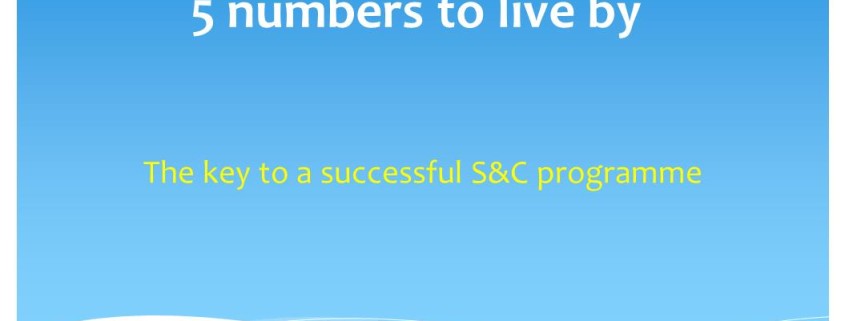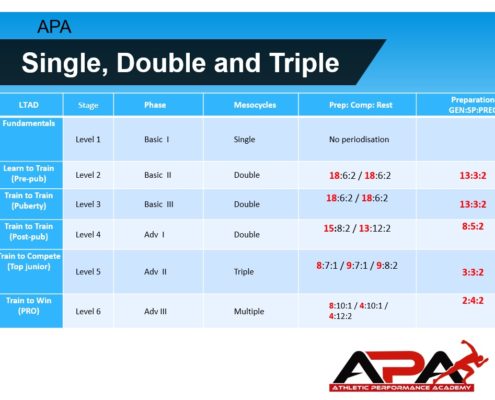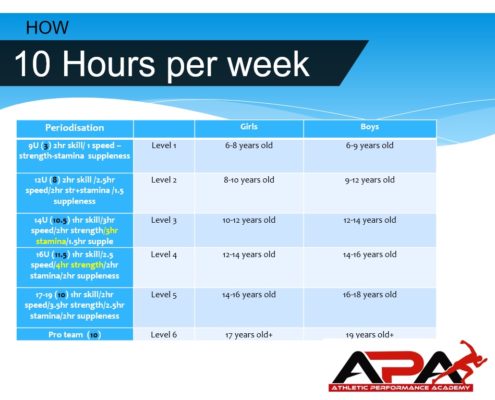The Key to Running a Successful S&C programme- 5 Numbers to Live By
Last Sunday I delivered a workshop on ”The Key to Running a Successful S&C Programme- 5 Numbers to Live By.”
This blog is a summary of the key take home messages from the workshop. I have narrated the presentation. If you want to listen to the whole thing I go for around 40 minutes but if you just want the key messages I have bullet pointed them below:
‘5’ Biomotor Abilities
Everyone who has a training philosophy will have their own pillars of Fitness that they refer to. Often times, we use different terms but we are referring to the same thing. However, we might have different views on what types of fitness to prioritise. I once heard that any philosophy needs a ‘Strategy’ and ‘Tactics’. The strategy is- how you believe you develop a component of Fitness. So for speed, a common idea is the short to long approach. Start with short distances with the required intensity and as they progress, increase the distance. The tactics are the specific means to deliver this strategy, namely your sets and reps.
For simplicity, at APA we talk about the 5 Biomotor Abilities:
- Suppleness
- Skill
- Strength
- Speed
- Stamina
When I first introduce myself as a Strength & Conditioning coach I like to make sure everyone has the chance to discuss with me what that actually means. I always say the ‘Strength’ part is more self explanatory but what about the Conditioning? And does the the S&C defintion miss anything? Conditioning in my book refers to the Speed and Stamina biomotors so in essence the Main role of a S&C coach is to get someone fitter, faster and stronger so they can excel in Sports. You will see me say that several times on the APA website. This really refers to the Olympic motto Citius, Altius, Fortius (Olympic motto).
But for me this speaks to the training part of the Performance Pyramid- when you’re trying to put some horsepower in the athlete. Underlying that we need to spend some time teaching the body how to move properly so the missing pieces refer to Suppleness and Skill.
Suppleness
I know most coaches are more familiar with the term flexibility, however this only really considers the properties of muscle. I prefer to talk about mobility- which is the available range at a joint. Linked to this is stability because it is important to have control of this range.
This aspect is key to movement efficiency- to enable your muscles to function the way they are supposed to. Having said that there has been a growing shift in S&C coaches who in my opinion are operating too much like a physio and this is not our expertise!! We need to have a good understanding of functional anatomy but we are not trained to diagnose injuries and we need to know when to refer on.
Skill
Even though skill is traditionally thought of as the domain of the sports coach there are a number of fitness components we can target to make it easier for athletes to acquire the skills of their sport. These focus around balance, coordination and reactions training. We are assisting the athlete to better organise their body’s by developing their senses especially vision, and proprioception. I call these ‘Athletic Skills.’
‘6 Stages of Development’
Often referred to as Long term Athlete Development, the APA training system spans 6 stages designed to progressively develop athleticism. I used to refer to Istvan Balyi’s model a lot (Fundamentals, Learning to Train, Training to train, Training to compete, Training to win) but more recently I refer more often to the key parts of the Tennis Academy programmes APA are involved in:
Mini Academy- Stage 1 (Basic 1)
Junior Academy- Stages 2 to 4 (Basic 2, Basic 3, Advanced 1)
Pro Academy- Stage 5 and 6 (Advanced 2 and 3)
Exercise Progression for every Biomotor:
The various parts of the Academy programme cross over the Basic to Advanced exercise progressions that we use at APA, with the idea that you can start doing more advanced training methods as you get to the end of the Junior Academy.
Another feature of the training system refers to what the priority should be in terms of which biomotor abilities are more important. So in the early years emphasis should be on movement efficiency, then strength/power and finally conditioning.
20,000 Hours
This topic has been beaten to death and in the end I think it is impossible to be able to quantify exactly how much training is appropriate for every individual. In the slide below I compare some ‘old’ guidelines from the Lawn Tennis Association (around 2003) versus new ones (2013). I highlight that if you do the recommended hours you will have accumulate 10,000 hours by 14 years, and then 20,000 hours by 20 years old. I suggest that this means you become an expert in technique by 14 and hopefully the next 10,000 hours are about training the skills you have mastered!!
Don’t get stuck in the numbers. It’s an average NOT a rule. I can be talented and make it on 6,000 hours. Less talented players might need more hours!! Its about deliberate quality practice. Of course it is possible that someone could make it on a 2 hour a day tennis programme!
Talent vs. Practice / HOURS will improve your talent or if you have moderate abilities iron out deficiencies but hours alone won’t do it- those will insufficient ability will get weeded out / Environment Parents like water: has an effect on fish, even if it doesn’t explain any of the differences in fish/ Inspiration and Perseverance Heritable but not completely deterministic TRAITS
‘9’ weeks per year
Nine weeks per year should be dedicated to physical training.
This is based on ‘emphasis.’ The LTA is saying that you need at least 9 weeks where S&C is the focus with rackets down. This can come in mini-blocks of 3 weeks- which may involve little to no tennis so you can get a head start with your physical work. I think the concept of a training block for a concentrated period of time with rackets down is an adult pro player model that is not appropriate to younger players . For the top juniors/pro players I would do this.
For the younger juniors I would try and plan work for the term according to my plan below and control how many weeks they are away each term. I prefer to plan the work around 2 (double) or 3 (triple) main blocks in the year- when they are younger we might expect them to be away from base competing for only 6 weeks in 6 months, so there is plenty of time to train them without needing to put rackets down! Post puberty they might be away for 2-3 months in a 6 month period. By the time they are a top junior they will be away 2 months out of every four!! So we may need to look at a physical block.
The weeks devoted to training below are idealistic. It is unlikely you will get 18, 15 or even 8 preparation (prep) weeks in a row to train with a tennis player without some kind of competition (comp) that comes bang in the middle of that. But rather, what it does is give you a sense of how many weeks you want to emphasise on a particular type of training before you move on. I’ll look to split the preparation period up into more general or more specific work depending on what is appropriate for the athlete.
’10’ hours per week S&C
So what exactly should you do with your training time? This again is almost as impossible to answer in a general sense as every individual is unique.
I’ve already touched on this before with the ‘6 Stages’ or levels of athletic development. In the slide above I’m actually referring the old LTA guidelines. Skill is a big focus on 10-under and 12-under S&C. Stamina and Strength become more important in later stages.
I liked Pat Etcheberry’s answer to this- six sessions a week, 2 speed, 2 strength and 2 stamina. It’s pretty simplistic but a good start point for people wanting to build their general fitness.
I talk about ‘focused’ versus ‘complex’ sessions. Athletes who are accessing our programme for 1-2 hours a week will do a complex session where in an hour we give them a ht of all the 5 biomotors. If we are working with a fuller-time athlete who is doing up to 10 hours per week with us they will do a focus session- meaning each session will focus on a particular type of fitness. I will then give each week a main theme for the week or training block so if it is speed, strength, stamina, or something else it is reasonable that more of the sessions will focus on that theme!
Want to hear more?
I will be presenting on these topics again later in the year as well as on my Level 2 S&C Certificate. Don’t forget it’s not too too get involved!!!
Level 2 Strength and Conditioning Qualification
Next Dates: 21/22 October, 18/19 November Location: Hertfordshire
I also have the following speaker engagements planned:
Coordination and Strength training for Sports
Dates: 29th October 2017 09:00AM-12:00PM Location: Gosling Sports Park, AL86XE
Tennis Fitness, Sport Science and Coaching Conference
Dates: 9th December 2017 09:00AM-12:00PM Location: Sheffield Hallam University Collegiate Crescent Campus, Sheffield , S102BP
Book your ticket HERE








